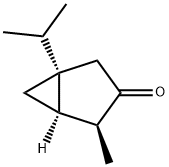THUJONE

- CAS No.
- 471-15-8
- Chemical Name:
- THUJONE
- Synonyms
- THUJONE;b-Thujone;β-Thujone;(Z)-thujone;(E)-Thujone;cis-Thujone;Thujone cis;beta-Thujon;D-isothujone;trans-Thujone
- CBNumber:
- CB7299582
- Molecular Formula:
- C10H16O
- Molecular Weight:
- 152.23
- MOL File:
- 471-15-8.mol
- Modify Date:
- 2024/6/28 13:52:33
| Melting point | 170 °C |
|---|---|
| alpha | D15 +72.5° |
| Boiling point | 84-86 °C17 mm Hg(lit.) |
| Density | 0.925 g/mL at 25 °C(lit.) |
| refractive index |
n |
| Flash point | 148 °F |
| storage temp. | 2-8°C |
| solubility | Practically insoluble in water, soluble in alcohol and oils. |
| form | Almost colourless mobile liquid |
| Odor | herbal warm |
| Dielectric constant | 10.0(0℃) |
SAFETY
Risk and Safety Statements
| Symbol(GHS) |  GHS07 |
|---|---|
| Signal word | Warning |
| Hazard statements | H302 |
| Precautionary statements | P264-P270-P301+P312-P330-P501 |
| Hazard Codes | T |
| Risk Statements | 23/24/25-36/37/38-42/43 |
| Safety Statements | 23-26-36/37/39-45 |
| RIDADR | UN 2810 6.1/PG 3 |
| WGK Germany | 3 |
| Toxicity | LD50 s.c. in mice: 442.2 mg/kg (Rice, Wilson) |
THUJONE Chemical Properties,Uses,Production
Chemical Properties
Powerful and penetrating, warm-herbaceous, the minty-camphoraceous odour of moderate to poor tenacity. Warm-herbaceous, bitter taste in concentrations lower than 10 ppm. Higher concentrations produce a pungent-bitter, herbaceous taste.
Uses
β-Thujone is a component of the essential oil of Pistacia vera L. It is also used as as a reactant in organic synthesis.
Definition
The monoterpenoid ketone Thujone is used sparingly in certain perfume formulations, often as a trace component of topnote compositions, and it blends very well with Oakmoss, Rosemary, Geranium, Galbanum and various green-herbaceous notes, and with certain Ambre-t ype fragrances. Herbs containing essential oils in which Thujone forms a major component have been under suspicion by the food authorities, and many products containing Thujone-beaning oils or extracts have been banned from food, beverages, etc. The toxicity of Thujone is roughly estimated at three times that of Nitrobenzene. However, it is not possible to compare the two since the effect of Thujone is entirely different, sometimes classified as “Curare-like” or paralyzing on the human CNS or heart system. The Thujone content of certain Artemisia species, used in “Absinth” alcoholic beverages, was responsible for banning certain brands of alcoholic beverages in the 1930s in France. Thujone is by some authorities considered the most toxic of all commonly occurring components of essential oils. Thujone is produced by isolation from various essential oils: Cedarleaf oil (Thuja oil), Tansy oil, Dalmatian Sage oil, etc.
THUJONE Preparation Products And Raw materials
Raw materials
1of2
chevron_rightPreparation Products
| Supplier | Tel | Country | ProdList | Advantage | Inquiry |
|---|---|---|---|---|---|
| TargetMol Chemicals Inc. | +1-781-999-5354 | United States | 19973 | 58 | Inquiry |
| ABCR GmbH & CO. KG | 49 721 95061 0 | Germany | 6846 | 75 | Inquiry |
| Penta Manufacturing Company | 973 740 2300 | United States | 5077 | 65 | Inquiry |
| BOC Sciences | 1-631-485-4226; 16314854226 | United States | 14059 | 65 | Inquiry |
| Riedel-de Haen AG | 800 558-9160 | United States | 6825 | 87 | Inquiry |
| VWR International | 800 932 5000 | United Kingdom | 6554 | 82 | Inquiry |
| SIGMA-RBI | 800 736 3690 (Orders) | Switzerland | 6913 | 91 | Inquiry |
| Zerenex Molecular Limited | +44 (0) 1204 527 700 | United Kingdom | 6205 | 47 | Inquiry |
| City Chemicals Corporation | 800-248-2436 | United States | 6462 | 72 | Inquiry |
| Pfaltz & Bauer, Inc. | (800) 225-5172 | United States | 6830 | 72 | Inquiry |
| Supplier | Advantage |
|---|---|
| TargetMol Chemicals Inc. | 58 |
| ABCR GmbH & CO. KG | 75 |
| Penta Manufacturing Company | 65 |
| BOC Sciences | 65 |
| Riedel-de Haen AG | 87 |
| VWR International | 82 |
| SIGMA-RBI | 91 |
| Zerenex Molecular Limited | 47 |
| City Chemicals Corporation | 72 |
| Pfaltz & Bauer, Inc. | 72 |
471-15-8(THUJONE)Related Search:
1of3
chevron_right




